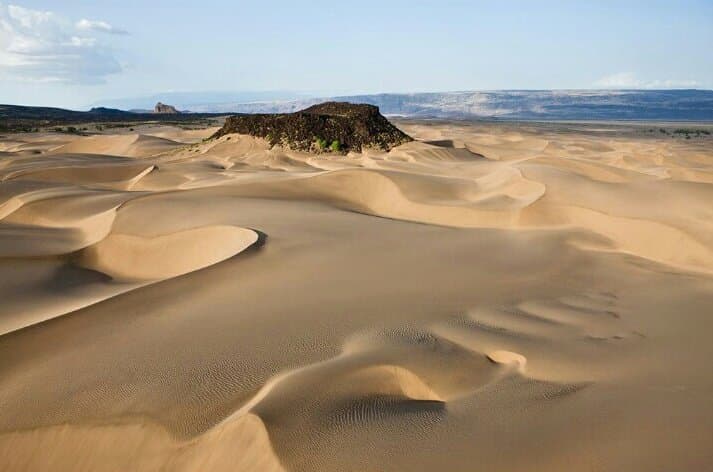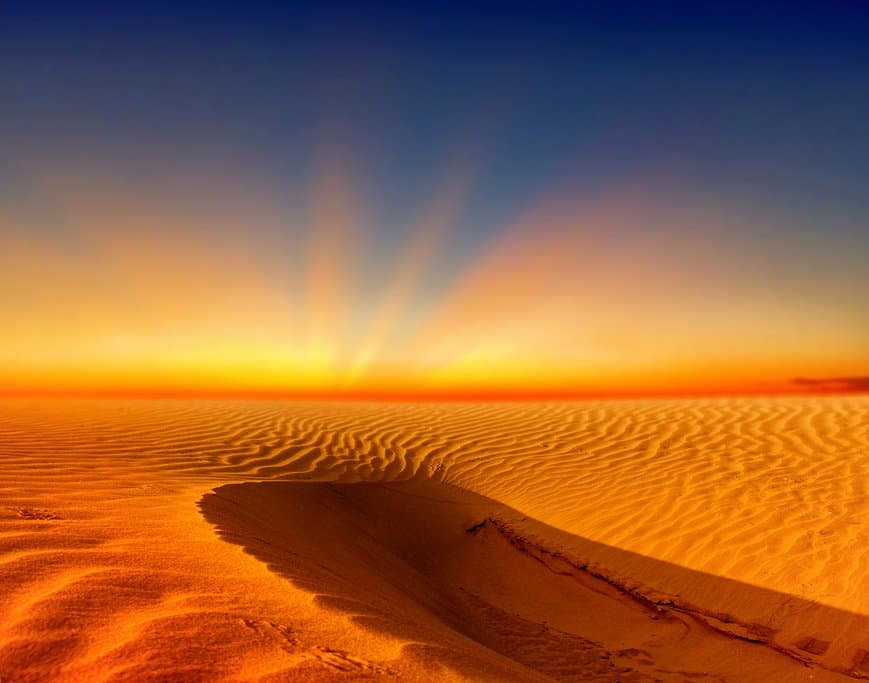Africa is full of wonders, from the longest river in the world to the most amazing Deserts. John Hemming once said, “If i have ever seen magic. It has been in Africa. I have prepared a list of the most amazing deserts in Africa. What makes a desert beautiful it is that hidden oasis and this list is all about finding each oasis of the top deserts in Africa.
10.) The Lompoul desert

The Lompoul desert is the smallest desert in Africa in this list and is located in north-western Senegal, between Dakar and Saint-Louis. Easy access makes the desert a popular tourist destination for visitors who want to admire the large orange sand dunes that surround it and reminiscent of the Sahara or Namib deserts.
Once a year, a festival known as the “Festival du Sahel” is held in the Lompoul dunes to highlight the culture and music of this region. Festival-goers explore the arena on camels and dance the night away with traditional instruments. Deserts in Africa are simply amazing.
Size, 18Km2
9.) The Grand Bara deserts

The Grand Bara desert located in South Djibouti was once a lake which has since dried up. It consists of large sandy beaches interspersed with scattered grass and desert shrubs. The desert is flat and arid, with scarce shrubs, several large mammal species have adapted to life in the region, including Dik-Dik, Oryx Beira Antelope etc.
Size 103Kms2
8.) Nyiri Desert (Deserts in Africa)

The Nyiri Desert, Desert is located in Southern Kenya near Amboseli National Park. East of Lake Magadi, it is located on the rainshadow region of Mount Kilimanjaro, this makes the desert receive minimal rainfall, surprisingly you will find large Mammals the likes of Elephants, Lions, Leopards, Rhinocerous and Great/ Lesser Kudu. Shrubs and baobabs are also found in this dry place.
Size 700km2
You can Also Read: List of Top 10 Longest Rivers in Africa
7.) Guban Desert.
The Guban is one of the great deserts in Africa. These beautiful Desert is located in North-Western Somalia between the Zeila and Berbera. The Name Guban refers to as Burnt Land. It is hot, Sandy and receives minimal rainfall throughout the year. It has a Steppe kind of vegetation. The temperatures are very high during the day accompanied by hot winds, visiting the place on a barefoot is not advisable, the people living around move during a certain part of the year due to the high Temperatures.
Size, 7000Km2
6.) The Namib Desert

The Namib Desert is the oldest desert in the world and one of the greatest deserts in Africa, it is around 80 million years old. It stretches covering 3 South African Countries, Angola, Namimbia and south Africa.
The climate is extremely dry due to the interaction between the dry Namib winds and the Benguela Atlantic current. It is these forces that form a dense fog that is the main source of water for many plants and animals in the desert. Namibia’s largest nature reserve is located in the desert: the epic Namib-Naukluft Park.
Size, 81,000Km2
5.) Chalbi Desert (Deserts in Africa)

The Chalbi Desert is located in northern Kenya, near the border with Ethiopia. It is located east of Lake Turkana and contains North Horr. Marsabit is the next largest urban centre.
The Chalbi desert has more to offer in picturesque and peaceful oases for worthy incredible moments. It is almost a miracle that such a cool and vegetative place can exist in such a huge region of sand and nudity.
Once in the Chalbi Desert, lately known as the UAE of Kenya, Many Kenyans are flocking the destination more frequently than before. You will not only enjoy camel riding but also be able to visit and explore Lake Turkana, National Park.
Size, 100,000Km2
4.) Danakil Desert

The Danakil Desert is located in northeastern Ethiopia and the coast of southern Eritrea and northwestern Djibouti. The desert has one of the harshest environments in the world. It has lava lakes, volcanoes, hot springs, geysers, and some impressive multi-coloured salt lakes.
Less than one inch of rainfall is recorded each year, and the Danakil Desert is one of the hottest deserts in Africa. Reaching Highs of up to 50°C/122°F.
Size, 136,956 km²
3.) Karoo desert (Top Deserts in Africa)

Karoo is a semi-desert natural region of South Africa defined by its topography, geology, and climate, especially its low rainfall of up to 10 inches per year and its extremes of heat during the day and cold at night.
The Karoo is divided into two distinct regions: the succulent Karoo Biome to the west and the Nama Karoo Biome, which covers much of the southern inland shelf. The succulent Karoo has the world’s richest flora in succulents, with around 10,000 succulent species. Groundwater is found through the Karoo, which has been exploited for decades by settlers and allows Nama Karoo to be used to graze sheep and goats.
The Karoo offers visitors vast plains, majestic mountains, an air of champagne, and the picturesque towns of Karoo steeped in history and intrigue. This makes Karoo one of the most Incredible deserts in Africa. Here you can explore the established route, on foot, horseback, mountain bike, 4×4 or canoe, and enjoy spectacular games and bird watching.
Size, 400,000 km²
2.) Kalahari Desert (Deserts in Africa)

The Kalahari Desert is a large semi-arid sandy savanna in southern Africa, spanning three countries: Botswana, Namibia, and South Africa.
Wildlife
The fauna of the Kalahari Desert survives in these arid conditions. The wetter north has a richer and more varied flora and fauna than the drier south.
Dryland wildlife includes springbok, gemsbok (oryx), wildebeest, kudu, steenbok, and duiker. Kalahari is home to desert specialities like meerkat, eared fox, cape fox and brown hyena. One of the most unexpected facts of the Kalahari Desert is it hosts three African big cats can be found here: the cheetah, the leopard and the famous black lions of the Kalahari. Making it one of the top deserts in Africa.
The Lions
The Kalahari Desert lions are different. They have longer legs and slimmer bodies, and the males have a much darker mane. They are built to have more resistance and their coat is also light. According to scientists, this is an advanced adaptation to their environment. Their light coat offers better camouflage and their flexible construction makes them faster and lighter.
The best place to see them is the Kgalagadi Transfrontier Park in the Kalahari Desert. Although you can see them in many places while travelling long distances while following their prey.
Birds
Birdlife includes the secretary bird, the Kori bustard, the ostrich, and a variety of birds of prey, including the martial eagle, giant owl, hawks, wood pigeons, kestrels, and kites. The landscape is dotted with huge nests of sociable weavers, precariously built on trees and telegraph poles.
Reptile
Many reptiles also live in the Kalahari, in particular Cape Cobra or yellow cobra, it is a poisonous snake native to southern Africa. Like other cobras, it flattens the hooded neck before attacking. It grows up to 7 feet. The scientific name, the puff pastry additives and many species of lizards. Surprisingly, some amphibians can even survive here, including the rain frog and tremolo. It is surprising to hear the frog chorus as soon as it rains.
Size, 930,000 km²
1.) The Sahara Desert

The Sahara Desert the top desert in Africa, Sahara means the largest Arabian desert, is a vast expanse of desert land. It is the largest desert in Africa and the third only after Antarctica and the Arctic. It is not completely dry, there are more than 20 lakes. It occupies almost all of North Africa. The desert is full of great oasis depressions, shallow flooded basins, sandy seas, sand dunes, layers of sand, rugged mountains, Rocky Mountains, and gravel plains. Its temperature is extremely high during the day and extremely cold at night.
Every 41,000 years, the Sahara alternates between the desert and grassy savanna. This is due to an oscillation of the Earth’s axis during its rotation around the sun, which changes the position of the North African monsoon and, therefore, subjects the Sahara landscape to a radical change.
However, despite the extreme conditions in the region, hundreds of animal species continue to live here. These animals of the Sahara Desert have adapted well to their environment because their bodies are well equipped to survive in the cruelty of nature. The Sahara Desert was home to big cats, but they have come a long way for what scientists have called the catastrophic collapse of wildlife.









